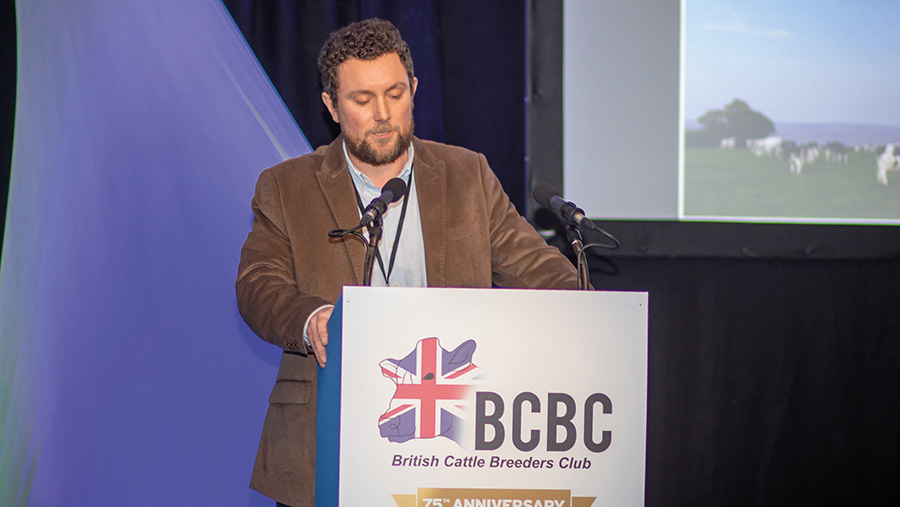How a spring-calving herd is driving genetic gain
Using genomics alongside three breeding indexes to select bulls has put a Welsh spring-calving herd in the top rankings for fertility and protein production.
Rhys Davies, who milks 100 Holstein Friesians in Flintshire under the Ffrwd prefix, originally milked Holsteins, but started cross-breeding his heifers in 2001.
However, a study trip to Ireland as part of a Farming Connect management exchange four years ago convinced him that robust breeding selection tools could help him breed better-performing black-and-white cows.

Rhys Davies © BCBC
See also: How a spring-calving herd started using genomics
“The only reason we were cross-breeding was because we wanted easy calving,” explains Mr Davies.
He says some of the disadvantages of cross-breeding were that he could not genomic-test these animals, and black-and-whites seemed to be outperforming cross-breds.
Farm facts: Moor Farm, near Holywell, Flintshire
- Milks 100 Holstein Friesians plus 80 youngstock
- Sells milk to Arla
- Calves from 1 March to 10 May
- Sells breeding stock
- Grazes from March until November
- Averages 7,500 litres at 4.59% fat and 3.65% protein
- Produces 618kg milk solids a cow a year
- Bought 10ha (25 acres) from the county council; still rents 30ha (73 acres) from the council and 40ha (100 acres) for silage from four landlords
Mr Davies decided to use a combination of Holstein Friesian genetics from around the world to fast-track genetic gain.
These included bulls with high estimated breeding indexes from Ireland, bulls that ranked well for breeding worth (New Zealand’s breeding index) and top bulls from the UK’s spring calving index (SCI).
He uses the AHDB’s bull search tool to get a UK evaluation for any non-UK bulls, which he says essentially converts everything into “one language”.
Breeding
Heifer calves are genomic-tested when they are two weeks old and then ranked for protein percentage, fertility index, maintenance and mastitis.
Heifers are matched to the best sires to balance traits accordingly.
“Genomic testing of heifers has become just as important as weekly grass measuring. Without it, I don’t know which heifers to keep. It is like going into the wrong paddock.
“If we get a heifer that needs improving for cell count, I will use a high-SCI Holstein bull.
“If we have a calf with good health traits, but she needs her components improving, I will use a high-percentage bull from Ireland or New Zealand,” says Mr Davies.
Surplus heifers are sold at two weeks or at bulling for £250-£300 and £1,000, respectively.
Sexed semen is used on heifers and cows for the first six weeks of breeding and conventional semen is used on any of their best cows that repeat after first service.
Aberdeen Angus semen is used on the rest, alongside the poorest animals from the start of mating.
Cows that fail to conceive in the nine-week breeding period are served again in November and sold to autumn calvers once they are confirmed in-calf.
“This brings in an income of £1,500-£1,600 rather than wasting them as culls,” says Mr Davies.
Collars are used to detect heats, with 84.7% of cows calving in nine weeks.
Cows graze from March until November, with heifers trained to an electric fence as soon as they are weaned off milk.
Milkers move to fresh paddocks after each milking, on 12-hour shifts. Grass is pre-mowed, which Mr Davies believes drives intakes, particularly in early lactation.
Benefits
Replacement ones and twos are now in the top 1% for fat and protein and fertility, based on the profitable lifetime index from Mr Davies’ most recent AHDB herd genetic report.
In the future, he hopes to improve cell count, with youngstock from the herd currently ranked in the 70th percentile for this trait.
He also wants to focus on the EnviroCow trait, which was released in 2021. This incorporates cow lifespan, milk production, fertility and feed conversion.
Rhys Davies was speaking at the 2023 British Cattle Breeders Conference on 25 January
